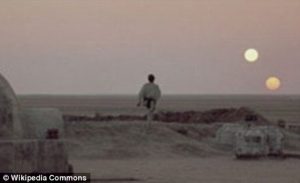Memo #171
By Paul Evans – paul.evans [at] ubc.ca
 Star Wars fans worldwide remember the iconic scene of Luke Skywalker peering into a sky at dusk with not one but two suns sinking over the horizon of his home planet of Tatooine.
Star Wars fans worldwide remember the iconic scene of Luke Skywalker peering into a sky at dusk with not one but two suns sinking over the horizon of his home planet of Tatooine.
In September 2011, science reinforced science fiction when NASA scientists employed data from the Kepler spacecraft to confirm the existence of planet Kepler-16b. Like Tatooine, Kepler-16b orbits two suns that in fact orbit each other.
For earth’s geopolitics, too, the data resuscitates a solar metaphor discredited since the era of Japanese imperialism in the 1930s.
For the past decade, analysts have argued about how to characterize our earthly balance of power. In a world described as multi-polar or multi-centric, the rise of China, India, and other emerging economies are reshaping both global commerce and the strategic balance.
States in Asia already acknowledge that their sky has two suns, primarily because almost all of them have China as their principal trading partner and almost all of them look to the United States as an ally or, at least, a regional balancer.
Australians are engaged in a national debate on how to navigate this two-sun sky, triggered in part by the writings of Hugh White on the difficult choices this presents.
Washington’s recent “pivot” toward Asia is based on the premise that China’s growing military and political power is the defining feature of US strategy.
The jury is still out on how strong China actually is, whether it is irrevocably enmeshed in a Western-dominated division of economic labour, and whether America is in decline. China may be more a moon or shooting star than a sun.
But no one disagrees that China’s rise is changing the pattern of geopolitics and geoeconomics in Asia and on a global scale. The interaction of the gravitational fields of China and the US adds a whole new dimension of complexity and is central to international politics in our era.
Meanwhile, Stephen Harper’s Ottawa has focused exclusively on commercial opportunities in Asia, remaining silent about the shifts in the strategic context. A look at the geopolitical heavens makes it clear that this needs to change.
About the Author:
Paul Evans – Director, Institute of Asian Research, The University of British Columbia.
 Links:
Links:
- ‘Star Wars’ planet discovered with two suns, The Guardian, September 2011.
- Australia in the Asian Century, Australian Government.
- Competing for Primacy in Asia, The New York Times, November 2011.
- America’s Pacific Century, Foreign Policy, November 2011.
- America ‘here to stay’ in the Pacific: Obama, ABC News, November 2011.
Related Memos:
- Our other Memos on China, United States, and Asia